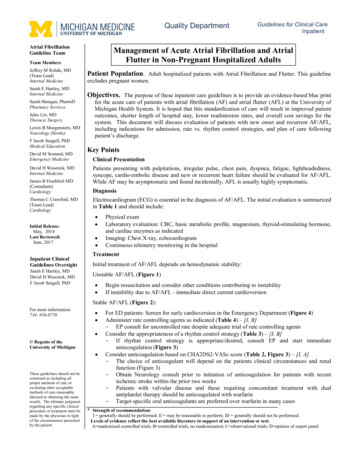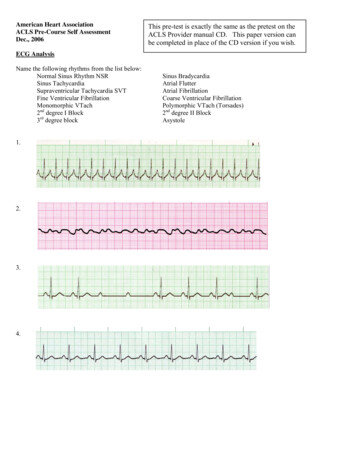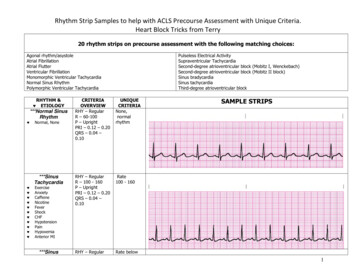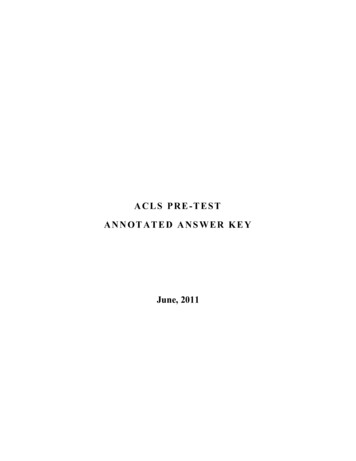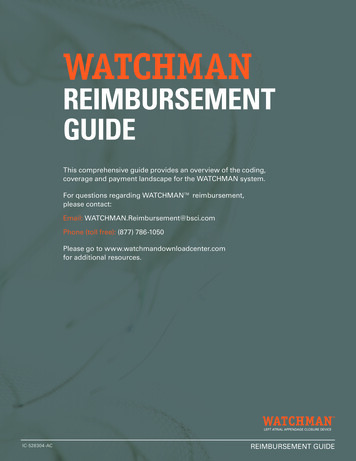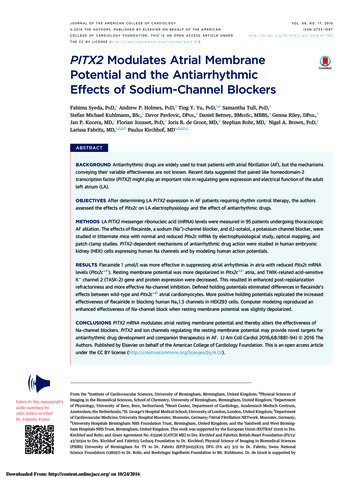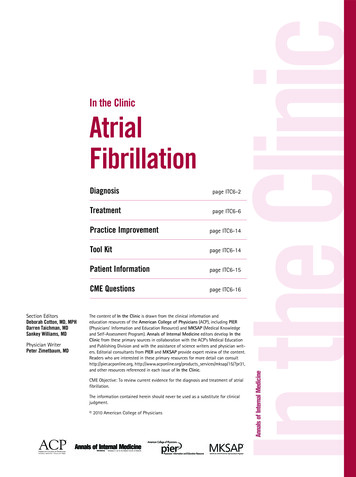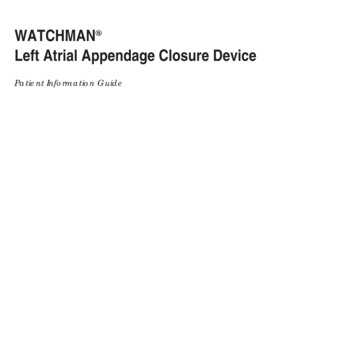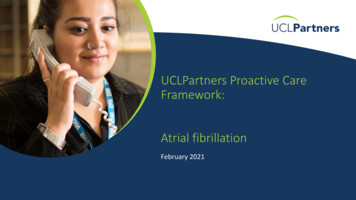
Transcription
UCLPartners Proactive CareFramework:Atrial fibrillationFebruary 2021
Supporting Primary Care to Restore and Improve Proactive Care COVID-19 has placed unprecedented pressure on our health system. This brings an added risk to people with longterm conditions who need ongoing proactive care to stay well and avoid deterioration. Disruption to routine care mayworsen outcomes for patients, increase their COVID risk and result in exacerbations that further increase pressure onthe NHS – driving demand for unscheduled care in GP practices and hospitals. As primary care transforms its models of care in response to the pandemic, UCLPartners has developed real worldframeworks to support proactive care in long term conditions. The frameworks include pathways for remote care,support for virtual consultations and more personalised care, and optimal use of the wider primary care team,e.g. healthcare assistants (HCA), link workers and pharmacists. Additionally, the frameworks include a selection of appraised digital tools, training and other resources to supportpatient activation and self-management in the home setting. This work has been led by primary care clinicians and informed by patient and public feedback. The UCLPartners frameworks and support package will help Primary Care Networks and practices to prioritise in thischallenging time and to focus resources on optimising care in patients at highest risk. It will support use of the widerworkforce to deliver high quality proactive care and improved support for personalised care. And it will help releaseGP time in this period of unprecedented demand. UCLPartners 2021
UCLPartners Proactive Care FrameworksUCLPartners has developed a series of frameworks for local adaptation to support proactive management of longterm conditions in post-COVID primary care. Led by a clinical team of GPs and pharmacists Supported by patient and public insight Working with local clinicians and training hubs to adapt and deliverCore principles:1. Virtual by default2. Mobilising and supporting the wider workforce (including pharmacists, HCAs, otherclinical and non-clinical staff)3. Step change in support for self-management4. Digital innovation including apps for self-management and technology for remotemonitoring UCLPartners 2021
UCLPartners Proactive Care Frameworks designed for local adaptationPrinciples: Virtual firstWider 1o care workforceStep change in self-managementDigital technologiesHigh priority – early reviewPrescribing clinicianHCA/other rolesStratify (clinical, ethnicity, socialfactors)Low priorityMedium priorityHigh priorityMedium priority – phased reviewPrescribing clinicianStructured supportfor education, selfmanagement andlifestyle change.Arrange bloods,collate data to informrisk assessment1. Begin with highest priority2. Use wider workforce to sharedelivery of care3. Innovation to support remotecare and self-careLow priority – holistic proactive careEg HCA, nursing associate, link worker etc UCLPartners 2021
Why the focus on Atrial Fibrillation?1Atrial fibrillation (AF) leads to a 5-fold increased risk in stroke and is responsible for 20% of all strokes.Anticoagulation reduces the risk of stroke by up to two thirds12If not anticoagulated, 25% of people who experience an AF-related stroke will die and over 50% of people willbe left with moderate to severe disability2. Each stroke costs the NHS and social care over 45k over 5 years33For most people, the benefits of anticoagulation significantly outweigh the risks4More effort should be made to address modifiable bleeding risk factors to allow patients to be safelyanticoagulated; proton pump inhibitors are underused and should be considered in all patients at high risk ofbleeding5People with AF are more likely to also have high blood pressure, high cholesterol, obesity or smoke, whichshould be addressed routinely to reduce the risk of heart attack, peripheral arterial disease, and dementiaReferences: 1. Hart et al, 2007; 2. Stroke Association, 2018; 3. Xu et al, 2017; UCLPartners 2021
Atrial fibrillation: stratification and management of stroke riskGather information Up to date bloods, BP, weight, smoking status, run CHA2DS2VASc, HASBLED, QRISK scoreHealthcare assistants/otherappropriately trained staffSelf managementEducation (AF/stroke risk, bleeding risk, CVD risk reduction), signpost to shared decisionmaking resources.Behaviour changeBrief interventions and signposting e.g., smoking, weight, diet, exercise, alcoholPriority OneNot onanticoagulantPriority TwoOn anticoagulant &antiplatelet/sPriority ThreeOn Warfarin (orOffer anticoagulantif indicated*Review need forantiplatelets*StratificationPrescribing clinicianother Vitamin Kantagonists)Priority FourOn DOACRenal function 12m agoPriority FiveOn DOACRenal function 12m agoCheck TTR foroptimal control*Check CrCl andreview dosage*Routine annualreview*Optimise anticoagulation therapy and CVD risk reduction1. Review: blood results, risk scores & symptoms2. Initiate or optimise anticoagulant3. Consider switch to DOAC if poor control on warfarin4. Check adherence and review any side effects5. Review and mitigate bleeding risk: BP control, medication, alcohol, PPI6. Optimise BP and lipid management to reduce cardiovascular risk7. Address rate and rhythm control as needed* For support/how to, click on link to take you to the relevant slide in this pack UCLPartners 2021
Pathways and resources1. Initiating DOACs2. Assessing stroke and bleeding risk3. DOACs: Calculating creatinine clearance4. DOACs: Dosing in non-valvular atrial fibrillation5. DOACs: Reviewing condition management6. DOACs: Choice of formulation7. Anticoagulation in people taking antiplatelet therapy8. Warfarin: Time in therapeutic range (TTR) monitoring9. Warfarin to DOAC switching UCLPartners 2021
Initiating DOACs*ResourceAction1 Check the patient has Non-Valvular AFDOAC contraindicated if mechanical prosthetic valve or known moderate to severe mitral stenosis2 Check CHA2DS2VAScOffer anticoagulation if CHA2DS2VASc 2 (consider if 1 in men)Ensure no contraindications to therapyDOAC contraindicated if pre-existing clotting disorder, pregnant, breastfeeding or planningpregnancy – seek specialist advice.For full list of contraindications see SmPCs at www.medicines.org.ukCheck: Bloods for renal function, LFTs, clotting4and FBC Bodyweight Creatinine Clearance (CrCl)Creatinine clearance calculationAll DOACs contraindicated if CrCl 15ml/min; Dabigatran contraindicated if CrCl 30ml/min5 Check bleeding risk with HASBLED scoreAddress modifiable risks identified by HASBLED score to reduce bleeding risk. Review othermedication – including antiplatelets and NSAIDs; consider PPIs6 Shared Decision Making (SDM) - agree whichDOAC dosing3DOAC to initiate. Correct choice of doseCounsel patient and agree a plan for follow up7 including monitoring blood testsDOAC monitoringProvide written information, an anticoagulant alert card and point of contact should issues arise*2014 NICE guidance recommends patients are offered DOAC or warfarin. If warfarin is appropriate, follow local pathways for initiation & monitoring UCLPartners 2021
Assessing stroke and bleeding riskStroke RiskCHA2DS2VAScScoreCHA2DS2VAScBleeding RiskNumber of AF-relatedstrokes avoided per1,000 AF patientstreated withanticoagulant therapyper year*Uncontrolled hypertension(systolic 160mmHg)1Abnormal liver function(Bili 2x ULN or AST/ALT/ALP 3x ULN117Abnormal renal function(Creat 200µmol/L, dialysis, transplant)1325Prior stroke/TIA14381557History of major bleed or predisposition(anaemia)Labile INR (on warfarin (TTR 60%)1Age 65 years1Medication usage predisposing tobleeding (Antiplatelets/ NSAIDS)1Alcohol ( 8units/week)1CongestiveHeart failure1Hypertension1Age 75 ge 65-74years1Female14Interpretation1. Offer anticoagulation to all patients (male or female) withCHA2DS2VASc 22. Consider anticoagulation in all men with CHA2DS2VASc 13. Antiplatelet monotherapy (Aspirin/Clopidogrel) is not recommendedfor stroke prevention in AF*Tables adapted from Y JavaidHASBLEDScoreHASBLED ScoreNumber of majorbleeds caused per1,000 AF patientstreated withanticoagulanttherapy per year*14212315421Interpretation1. HASBLED 3 indicates a higher bleeding risk2. Address modifiable bleeding risk factors to reduce HASBLED score e.g. lower BP, reviewconcomitant drug therapy, reduce alcohol intake3. Consider a proton pump inhibitor to reduce upper GI bleeding UCLPartners 2021
DOACs: Calculating creatinine clearanceeGFR should not be used to guide dosing decisions for DOACs1Use actual bodyweight (within 1 year) to calculate Creatinine Clearance (CrCl) If weight 50kg or 120kg or if BMI 40 : seek specialist adviceUse renal function checked within last 3 monthsCalculate CrCl using Cockcroft Gault equation Be cautious with calculators integrated into GP IT systems as they may default toideal bodyweight resulting in underdosing of DOAC Use MDCalcCrClMonitoringinterval 60ml/minAnnually30-60ml/min6-monthly 30ml/min3-monthlyAdjust DOAC dose if necessarySee slide on DOAC dosing in NVAF1. https://bmjopen.bmj.com/content/3/9/e003343 UCLPartners 2021
DOACs: Dosing in non-valvular atrial an*Standard dose5mg BD150mg BD60mg OD20mg ODReduced dose2.5mg BD110mg BD30mg OD15mg ODCriteria for dosereduction2 or more of: Age 80 Body weight 60kg Cr 133μmol/L1. Age 802. On verapamil3. Consider dose: Reflux/gastritis Age75-80 CrCl 30-50ml/min “Bleed risk”1 or more of: CrCl 15-50ml/min Body weight 60kg On rCl 15-49ml/minCrCl 30ml/minCrCl 15ml/minCrCl 15ml/minOrCrCl 15-29ml/minContraindicated / NotrecommendedCrCl 15ml/minCheck for common drug interactions &possible contraindicationsBleeding risk increased byAntifungal agentsNSAIDsRifampicinAntiplateletsPhenytoin and anti-epilepticsLong term oral steroid useAntiretroviralsAntidepressants: SSRIs/SNRIsChemotherapy* SmPCs all available at www.medicines.org.uk; UCLPartners 2021
DOACs: Reviewing managementThis review template is designed for review 1 month after initiation and according to the monitoring intervalEligibilityMonitoring intervalParameter All patients on DOACAnnuallyFBC, Renal & Liver function(calculate CrCl, weight) CrCl 30–60 mL/min6 monthlyRenal function Patients over 65 years and /or frail6 monthlyFBC, Renal & Liver function, weightCrCl 15–30 mL/ml3 monthlyRenal function Address bleeding riskIndividually agreedRenal & Liver function /- FBC Adherence check Review medicines and Eg: intercurrent illness that mayimpact on renal or hepaticfunctionAnnual clinical review* to include: Reassess stroke risk usingCHA2DS2VASc Update QRisk and manage CVDrisk factorsappropriate dosing Missed/delayed dose advice Alert card check* Follow local DOAC clinical review protocols where available UCLPartners 2021
DOACs: Choice of formulationConsiderationOptionMost suitable DOACFrequency of tablets/capsulesOne tablet once a dayEdoxaban/rivaroxabanOne tablet or capsule twice a dayApixaban/dabigatranTake with or without foodApixaban/dabigatran/ edoxabanTake with foodRivaroxabanSuitable to go in compliance aidApixaban/edoxaban/rivaroxabanWith or without foodUse of a compliance aid(dosette box)(Cannot use dabigatran in dosette box)Swallowing difficulties or feeding tubeLactose intolerant patientCAN be crushedApixaban/edoxaban/rivaroxabanCANNOT be crushedDabigatranDabigatran/edoxaban UCLPartners 2021
Anticoagulation in people taking antiplatelet therapy Antiplatelet therapy is not recommended for stroke prevention in AF; oral anticoagulants should be used.Some patients with AF are on antiplatelet therapy as treatment for vascular disease. See guidance belowIndication for antiplateletsAntiplateletAction when initiating anticoagulation for AFPrimary prevention of CVDAntiplatelet monotherapyStop antiplatelet therapy (antiplatelet therapy notrecommended for primary prevention of CVD)Secondary prevention of CVD Stroke / Transient Ischaemic Disease (TIA) Stable coronary heart disease (CHD) Peripheral arterial disease (PAD)Antiplatelet monotherapyorLow dose rivaroxaban withaspirinStop antiplatelet therapyPatients within 12 months of an ACS or stentplacement (cardiac or vascular)Aspirin plus clopidogrel,ticagrelor or prasugrelSeek specialist advice to agree the preferred drugregimen. Triple therapy (dual antiplatelet plusanticoagulant) duration must be clearly defined.Patients more than 12 months after an ACS or stentplacement (cardiac or vascular)Antiplatelet monotherapyStop antiplatelet therapy2 or more antiplateletsSeek specialist adviceIncrease DOAC dose (to AF stroke prevention dose) andstop aspirinWhen using an anticoagulant plus an antiplatelet – add a proton pump inhibitor (PPI)Adapted from: ticoagulation-with-warfarin-4th-edition/ Page 318-319and ice-Guidelines/Atrial-Fibrillation-Management Page 61 UCLPartners 2021
Warfarin: Time in Therapeutic Range (TTR) monitoring For effective stroke prevention with warfarin, time in therapeutic range (TTR) should be maintained 65% INR should be checked at least 12 weekly in patients with stable INR – target INR in AF is 2.5 (range 2-3) All patients should have TTR calculated at each INR visit Reassess anticoagulation if poor control as shown by:o 2 INR values 5 or 1 INR value 8 within the past 6 monthso 2 INR values 1.5 within the past 6 monthso TTR less than 65% If possible, address modifiable factors that may contribute to poor control:o Adherence, Illness, interacting drugs, diet and alcohol consumptionIf anticoagulation control cannot be improved, consider switch to DOACs, and discuss with the patient UCLPartners 2021
Warfarin to DOAC switching1Confirm the indication for warfarin is stroke prevention in AF2Exclude patients with contraindications to DOACs3Involve the patient in a shared decision to switch from warfarin to a DOAC4Check bodyweight and bloods for INR, renal function, LFTs, and FBC5Calculate CrCl using Cockcroft Gault equation6Decide which DOAC to use and what dose7Advise patient when to stop the warfarin and start the DOAC: INR should be 2.5 before initiating DOAC DOAC may need to be withheld or 24-48 hours after stopping warfarindepending on the measured INR8Provide written information, an anticoagulant alert card and ensure they have apoint of contact should issues ariseClick for detailed guidance on safeswitching UCLPartners 2021
Digital Resources
Digital Resources to support self management: Atrial FibrillationLiving with Atrial FibrillationBritish Heart Foundation - itions/atrial-fibrillationStarting anticoagulationStarting anticoagulation with Jack - https://vimeo.com/206257430Don’t wait to anticoagulate - http://www.dontwaittoanticoagulate.com/Educational video resources for patients created by UCLPartners - os/Patient organisationsThe AF Association has information for patients - -resourcesAnticoagulation UK - ned.pdfProviding information and recipes for easy ways to eat better from the ‘One You’ websiteNHS advice on lowering cholesterol levelsSmoking cessationNHS support, stop smoking aids, tools and practical tipsExerciseiPrescribe app offers a tailored exercise plan by creating a 12-week exercise plan based on health information entered by the userGetting active around the home: tips, advice and guidance on how to keep or get active in and around the home from Sport EnglandDance to health: Online dance programme especially tailored to people over 55 years oldAlcoholHeart UK alcohol guidance & NHS Drink Less guidance UCLPartners 2021
Digital Resources to support clinical management: Atrial FibrillationVideo resources (What is anticoagulation; I am on a DOAC; Starting a DOAC; Anticoagulation in VT; Anticoagulation in atrial fibrillation; Switching fromwarfarin to a DOAC) created by UCLPartners os/Cockcroft-Gault Equation oft-gault-equationRCGP ModuleThe Royal College of General Practitioners has now launched a new e-module to help healthcare professionals not only learn about Atrial Fibrillation, butalso about the current national guidelines to clinical practice. https://elearning.rcgp.org.uk/course/info.php?id 262Locally commissioned digital tools:AF Toolkit – www.aftoolkit.co.ukUCLP Proactive Care resources to address additional CVD and respiratory conditions can be accessed here UCLPartners 2021
Proactive Care Frameworks: implementation & support packageImplementation Support is critical to enable sustainable and consistent spread.UCLPartners has developed a support package covering the following components:Search and stratifyComprehensive search tools for EMIS and SystmOne to stratify patients Pre-recorded webinar as to how to use the searches Online Q&A to troubleshoot challenges with delivery of the search toolsWorkforce trainingand supportTraining tailored to each staff grouping (e.g. HCA/ pharmacist etc) and level of experience- Delivery: Protocols and scripts provided/ training on how to use these underpinned with motivationalinterviewing/ health coaching training to enable adult-to-adult conversations- Practical support: e.g. correct inhaler technique; correct BP technique, Very Brief Advice for smokingcessation, physical activity etc- Digital implementation support: how to get patients set up with appropriate digital- Education sessions on conditions- Communities of PracticeDigital support toolsDigital resources to support remote management and self-management in each conditionImplementation toolkits available where required, e.g. MyCOPDSupport available from UCLP’s commercial and innovation team for implementation UCLPartners 2021
Thank youFor more information please contact: partners
therapy per year* 1 4 2 12 3 15 4 21 Interpretation 1. HASLED 3 indicates a higher bleeding risk 2. Address modifiable bleeding risk factors to reduce HASBLED score e.g. lower BP, review concomitant drug therapy, reduce alcohol intake Consider a proton pump inhibitor to reduce upper GI bleeding Stroke Risk Bleeding Risk *Tables adapted from .
